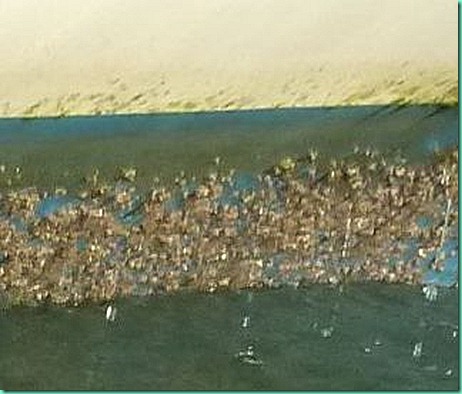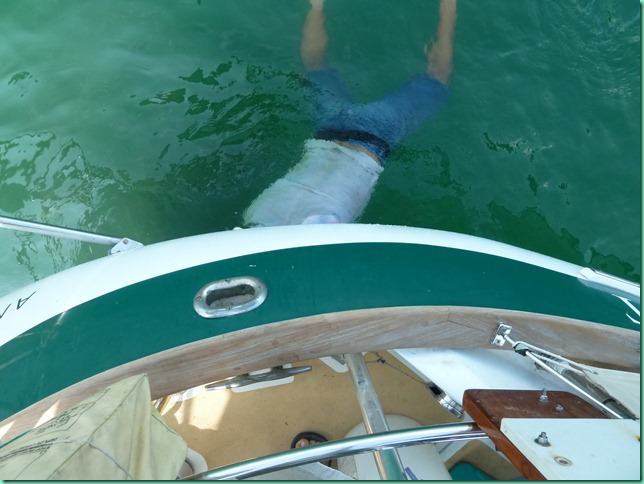A dirty little secret of Cartagena is the foulness of the water in the harbor; not (generally) in the oily, trashy sense, but in being a ‘hot’ primordial broth of barnacle larvae, and barnacle food (zooplankton and algae). We’ve been here for 47 days, came with a fresh clean bottom painted in November, and now look:
In the first two weeks we wondered what the fuss was about. In the third week things began to happen, but were easy to dismiss. In the fourth week we began to get alarmed.
As the barnacles grew we could actually hear the changes. Wavelets striking the side began to make a sleety, sizzley sound, like surf departing a rocky beach. Drainage thru the galley sink slowed, and the marine toilet began making sucking noises thru the sink.
We had coated the prop and shaft with lanolin, but that wasn’t working any more (if it ever had), as we found when we had to actually move the boat. How the ships of yore ever managed to keep up with the problem I can’t imagine. Careening, and diving, are limited options and even rocket scientists haven’t succeeded at prevention.
The mini-economy at the Club Nautico of Cartagena provided a local specialist to deal with the issue. You want your bottom cleaned? Alberto is the man. He came out to the boat in the anchorage with mask, fins, snorkel, 2 scrapers, and a screwdriver, no scuba tank. An hour or so later, the bottom was clean again.
Long-term residents of the Club Nautico and anchorage have Alberto do their bottoms every three weeks. Longer than that, he says, and the biggest barnacles get their teeth into the bottom paint; then they take the paint with them when they go. Use a scraper, (Alberto uses an 8-inch drywall blade, just as we do), not a brush, or after three or four times there will be no bottom paint left. To clean the anchor chain, don’t poke at every link or you’ll be there for hours. Rather, use the snubber to make a slack catenary* and rub handfuls of chain links with themselves to knock off the barnacles. The screwdriver is for the thru-hulls.
Over drinks at happy hour, someone commented that barnacles were attracted to places where barnacles had already been. The siren scent of barnacle balm? Intrigued by the thought I looked it up, and of course it’s sort of true. There’s a hatching pheromone triggered by algal blooms which cause dormant eggs to be released to form free-swimming larvae. And there’s the dread ‘settlement pheromone’, which attracts other barnacles into the range of the ‘highly extensible’ pseudo-penis which every hermaphroditic barnacle possesses. Yes, one barnacle can reproduce itself, but usually the male stage comes first and roams the neighborhood.#160;
However, where there’s a pheromone, there’s the potential for a targeted anti-pheromone, and it appears that current barnacle-busting hopes are pinned to a chemical, medetomidine, that turns the settlement receptors into a‘don’t settle here’ sign. Barnacles do go where barnacles have been, because they like the surface, so other researchers are trying to design textured barnacle-repelling bottoms for ships. Charles Darwin wrote one of the definitive papers about barnacles, but because of the enormous economic implications for world shipping, there is still a lot of research in the area. Barnacles are positively charismatic compared to, say, Archaeocyatha, a fossilized, extinct tropical sponge. Maybe I’ve missed my calling, (again).
Barnacles are crustaceans, related to crabs and lobster, not mollusks. They attach with their antenna, using a ‘cement gland’ and stay put (sessile) for the rest of their lives, which can be 3-5 years. They gather passing nutrients with their feet. Had we cared to measure, we could have analyzed more stringently the nature of the harbor water; barnacles can serve as biomarkers because of the amounts of toxic metals they can absorb.
Had enough of barnacles? Me too! In fact, when I was maybe ten, a small red dinghy and I spent a miserable winter weekend together at the top end of a boat shed, with a three-cornered paint scraper and a sheet of sandpaper. My orders were to ‘make that bottom clean’. I’ve just met folks on another boat who pull up and scrub their anchor chain every three days. It’s a nuisance to be sure, but it’s better, and easier, than arguing with a barnacle.
Wikipedia, and The Environmental Physiology of Animals by Wilmer and Stone were consulted in this gross oversimplification of the life of barnacles. Another interesting website is http://www.fathom.com/feature/121900/index.html
*ten cents’ worth about the snubber: we anchor with chain; it’s strong, but hasn’t much ‘give’ to it. So we tie or hook a shortish piece of stretchy line, a snubber, from the chain to the deck cleat, to ease some of the chain’s loading. Otherwise, when conditions get bouncy, the chain would want to yank the bow off the boat. The catenary is the curved bit of chain that hangs between the two fixed points. Handy to know, ‘cadena’ is chain in Spanish.


Bobby brought home a rope covered in live barnacles, in a small fish tank, when he worked out on hart Miller Island… We LOVED watching their tongue like thing sweep the water…
But OUCH… Sounds like you have “too much of a good thing”!!!
Bobby brought home a rope covered in live barnacles, in a small fish tank, when he worked out on hart Miller Island… We LOVED watching their tongue like thing sweep the water…
But OUCH… Sounds like you have “too much of a good thing”!!!